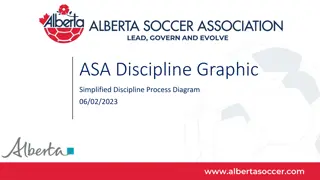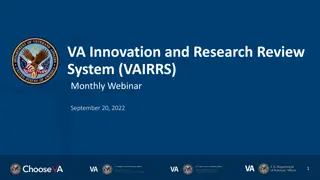Challenges and Opportunities in Oncology Drug Development: A Biostatistical Perspective
The field of oncology presents unique opportunities for advancing drug development through novel therapeutic modalities like immunotherapies, cell and gene therapies, and radioligand therapies. However, regulators, sponsors, and payers face criticism, often due to non-significant results in overall survival and disparities with clinical practice. Understanding the role of estimands, industry initiatives, and improving methodologies are essential for enhancing outcomes and addressing challenges in oncology drug development.
Download Presentation

Please find below an Image/Link to download the presentation.
The content on the website is provided AS IS for your information and personal use only. It may not be sold, licensed, or shared on other websites without obtaining consent from the author. Download presentation by click this link. If you encounter any issues during the download, it is possible that the publisher has removed the file from their server.
E N D
Presentation Transcript
Hematology Development Unit Biostatistics Estimand framework: What are the opportunities in oncology? Evgeny Degtyarev ASA BIOP/PSI/EFSPI Webinar, Nov 2020
Industry Industry Working Group on Working Group on Estimands www.oncoestimand.org www.oncoestimand.org Estimands in Oncology in Oncology 2020 Sep: Webinar on causal inference with academia 2020 June: Webinar with Clinical and Stats speakers from industry and EMA Feb 2018: initiated as informal WG to discuss draft ICH E9 (R1) and its impact on oncology Jun 2019: status of ASA Biop SWG granted 2019: 19 talks at 9 conferences Sep 2019: ESMO poster on estimands in adjuvant RCC presented by KOL Nov 2018: status of EFSPI SIG granted 27 companies from Europe, US and Asia (pharmaceutical, biotech and CRO) in dialogue with HAs from Canada, China, Europe, Japan, Switzerland, Taiwan, UK and USA Recordings of the webinars, slides from all presentations as well as published papers available on our homepage 2
Oncology Oncology drug Advanced Advanced therapies therapies improving drug development development today improving outcomes outcomes for today for patients patients New therapeutic modalities: Immunotherapies Cell&Gene Therapies Radioligand Therapies Great for patients! durable responses many ongoing clinical trials 3
Oncology Oncology drug Regulators, Regulators, sponsors sponsors and drug development development today and payers payers criticized criticized today 4
Oncology Oncology drug Regulators, Regulators, sponsors sponsors and drug development development today and payers payers criticized criticized today Negative perception often driven by non-significant result for overall survival, often when subsequent therapies don t reflect clinical practice! 5
Overall Overall survival survival (OS) in Treatment Treatment Switching Switching (OS) in clinical clinical trials trials Other therapies Drug A EOT Follow-up till death R Other therapies SOC EOT OS usually analyzed using treatment policy strategy using time from randomization to death regardless of patient s journey captures effect on the choice and impact of subsequent therapies note: balance in subsequent therapies generally not expected as physician choose subsequent therapy in light of previously administered therapies Clinically meaningful if choice of subsequent therapies after EOT reflects clinical practice 6 SOC: Standard of Care; EOT: End of treatment
Overall Overall survival survival (OS) in Treatment Treatment Switching Switching (OS) in clinical clinical trials trials EOT Drug A SOC R EOT SOC Other available therapies Drug A approved as next-line therapy after SOC Drug A choice of subsequent therapies after EOT reflects clinical practice Treatment policy OS estimand interpretable at the time of the readout 7
Overall Overall survival survival (OS) in Treatment Treatment Switching Switching (OS) in clinical clinical trials trials EOT Drug A SOC R EOT SOC Other available therapies Drug A and drugs with the same MoA not approved as next-line therapy after SOC Drug A (e.g. cross-over per study design or patients switching after positive primary PFS analysis) choice of subsequent therapies after EOT does not reflect clinical practice Treatment policy estimand comparing Drug A followed by SOC or other available therapies vs SOC followed by Drug A or other available therapies relevant? Benefit on OS without cross-over possibility more informative? (hypothetical estimand) 8 SOC: Standard of Care; EOT: End of Treatment; PFS: Progression-Free Survival
Oncology Oncology clinical Estimand Estimand framework framework: : Opportunity clinical trials Opportunityto trials today to improve improve communication communication! ! today Opportunity to discuss alternatives for main OS analysis addressing relevant questions for patients and prescribers (e.g. hypothetical estimand evaluated by RPSFT, IPCW ...) communicate added value of approved drugs better in publications improve OS description in the labels? Sutent US Prescribing Information in RCC (>10 years ago!) Nivolumab Summary of Product Characteristics 9
Few Few thoughts thoughts on ICH E9(R1) addendum acknowledges that some hypothetical scenarios are likely to be of more clinical or regulatory interest than others on the the Hypothetical Hypothetical estimand estimand Hypothetical estimands often targeted as primary analysis in pivotal trials PFS analysis censoring new anticancer therapies per FDA guideline proposed in EMA guidelines for Alzheimer or Diabetes What would be the effect on OS if patients from the SOC arm had not the possibility to receive Drug A subsequently? key question for patients and prescribers if Drug A is not available after SOC statistical methods such as IPCW can answer this question if properly planned (incl. data collection) facing some headwinds as the methods rely on assumptions Opportunity for sponsors and regulators to learn together and to collaborate with academia to address important questions for patients! 10
I Improved mproved HA that that we we get Case study in CAR-T setting presented in a recent webinar* on causal inference: Commenting on the protocol FDA stated that the analysis plan should prospectively create rules for appropriately censoring certain observations in supplementary analysis Sponsor realized that this censoring would target a hypothetical scenario that is likely not of clinical or regulatory interest Sponsor suggested that principal stratum estimand would address FDA s actual question of interest FDA agreed to use the principal stratum strategy as supplementary analysis instead of censoring Improved interactions discussing questions of interest and not censoring rules resulting in more meaningful analyses Principal stratum: another opportunity to learn together and to collaborate with academia addressing important questions many examples of practical relevance in drug development (Bornkamp** et al. (2020)) HA interactions interactions ensuring get the the questions questions right ensuring right 11 * RCTs meeting causal inference: principal stratum strategy and beyond http://bbs.ceb-institute.org/?p=1587 ** Bornkamp et al. Principal Stratum Strategy: Potential Role in Drug Development (2020). Under revision. arXiv:2008.05406
Other Other opportunities opportunities Harmonization of therapeutic guidances between regulators?! More focus on questions of interest than censoring rules in future? RWE structured discussion about the question of interest and planned comparison between single arm trials and RWD with regard to population, endpoint, handling of intercurrent events etc (or when supplementing control arm in randomized trial) transparent description of potential limitations and uncertainties to decide whether RWD source is suitable for comparison similar to target trial framework* 12 *Danaei G, Garc a Rodr guez LA, Cantero OF, Logan RW, Hern n MA. Electronic medical records can be used to emulate target trials of sustained treatment strategies. J Clin Epidemiol. 2018 Apr;96:12-22. doi: 10.1016/j.jclinepi.2017.11.021.
Just Just some some topics topics requiring requiring discussions discussions New task forces of the industry WG on Estimands in Oncology: Clinical engagement Principal stratum use for treatment switching Estimands and PRO Estimands and time to response/duration of response Follow-up quantification Estimands and RWE Conditional and marginal effects Time to event endpoint with prognostic or predictive biomarker subgroups 13
Conclusions Conclusions Opportunity to improve perception that approved drugs do not provide benefit with more patient-focused drug development addressing questions relevant to patients ensuring clarity in interpretation of results and added value of the drugs impact on labels and publications more dialogue in future between all stakeholders about questions of interest Opportunity for sponsors and regulators to learn together and to collaborate with academia to address important questions for patients! Successfully done before, e.g. Bayesian designs for dose-finding in Oncology instead of traditional 3+3 14
Acknowledgements Acknowledgements Thanks for many discussions on estimands in Oncology over the last years to: Kaspar Rufibach and many other members of the industry working group Frank Bretz and many other colleagues at Novartis 15
Industry Industry Working Group on Working Group on Estimands Webinars Webinars and and Publications Publications Estimands in in Oncology Oncology EFSPI/BBS Webinar: Estimands addendum is final: Anything new for oncology? (June 29) http://bbs.ceb-institute.org/?p=1453 BBS Webinar: RCTs meeting causal inference: principal stratum strategy and beyond September (September 7) http://bbs.ceb-institute.org/?p=1587 Accepted or published Lawrence, R., Degtyarev, E., Griffiths, P., Trask, P., Lau, H., D Alessio, D., Griebsch, I., Wallenstein, G., Cocks, K., Rufibach, K. What is an estimand & how does it relate to quantifying the effect of treatment on patient-reported quality of life outcomes in clinical trials (2020). Journal of Patient- Reported Outcomes, 4(1):68. DOI: 10.1186/s41687-020-00218-5 Degtyarev, E., Rufibach, K., Shentu, Y., Yung, G., Casey, M., Englert, S., Liu, F., Liu, Y., Sailer, O., Siegel, J., Sun, S., Tang, R., Zhou, J. Assessing the impact of COVID-19 on the objective and analysis of oncology clinical trials application of the estimand framework (2020). Statistics in Biopharmaceutical Research. DOI: 10.1080/19466315.2020.1785543 Casey M., Degtyarev E., Lechuga M.J., Aimone P., Ravaud A., Motzer R., Liu F., Stalbovskaya V., Tang R., Butler E., Sailer O., Halabi S., George D. Estimand framework: Are we asking the right question? A case study in the solid tumor setting (2020). Pharmaceutical Statistics, accepted. Under review Sun, S., Weber, J., Butler, E., Rufibach, K., Roychoudhury, S. Estimands in Hematology Trials (2020). Under revision. arXiv:2010.00957 Manitz, J., Kan-Dobrosky, N., Buchner, H., Casadebaig, M.L., Degtyarev, E., Dey, J., Haddad, V., Fei, J., Martin, E., Mo, M., Rufibach, K., Shentu, Y., Stalbovskaya, V., Tang, R., Yung, G., Zhu, J. Estimands in clinical trials with treatment switching (2020). Under revision. Bornkamp, B., Rufibach, K., Lin, J., Liu, Y., Mehrotra, D., Roychoudhury, S., Schmidli, H., Shentu, Y., Wolbers, M. Principal Stratum Strategy: Potential Role in Drug Development (2020). Under revision. arXiv:2008.05406 Further publications are currently being written within the working group. 16























